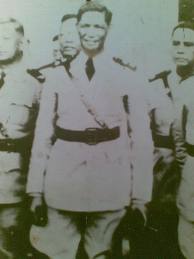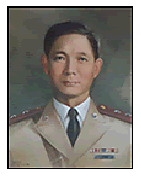Gen. Paulino Santos

Paulino Torres Santos (June 22, 1890 – August 29, 1945)
Gen. Santos was born in Camiling Tarlac to Remigio Santos and Rosa Torres. After his Spanish education from 1897 to 1900, he enrolled in an English school in 1901. In 1907, when he had finished the sixth grade, he was appointed as municipal teacher, a post which he held until the following year. In 1908, at age 18, he was an enlisted man in the Philippine Constabulary (PC) and he had just completed his first enlistment when he was named civil service clerk at the PC headquarters in 1912. That same year, he enrolled in the Constabulary Officers’ School (the precursor of the Philippine Military Academy) wherein, two years later, he graduated valedictorian. Santos was appointed as Third Lieutenant of the PC in 1914, and as such, he worked hard and continued studying to be more effective in his assignment as a field officer. General Santos was married to Elisa Angeles of Bulacan, with whom he had seven children.
As A Soldier
As soldier, Santos served in the Lanao campaign in 1916, where he sustained wounds from a Moro spear, and in the Bayang Cota campaign in 1917, where he was wounded anew, but this time by bullets.
On the 26th of July 1917, as government cannons were bombarding the Muslim bulwark of Lumamba,
on the lake shores of Lanao. Then 2nd Lieutenant Santos led his platoon from three companies of Philippine Scouts in penetrating the formerly secure redoubt, through an opening made in the barricade, and immediately erected a ladder to scale the first kota. Immediately, he and his men engaged its defenders in a bloody hand-to-hand combat, killing 30 of them, and thus preserving the lives of government soldiers. With only one casualty and four wounded.
For this exceptional military feat, Governor General Frank Murphy bestowed on him, the medal of valor, the highest military award, for “gallantry in action”, just before the inauguration of the Commonwealth government in 1935. He was named President Quezon’s aide for the inaugural ceremony. In 1937, President Quezon gave him the difficult and dangerous task of minimizing, if not eliminating the problem of Moro piracy in the south through the destruction of the pirates’ kotas, particularly Kota Dilausan, in Lanao. His term as Army chief of staff ended in December 1938
As Governor
In 1917, Paulino Santos became the first provincial commander of Lanao and Sulu. As commandant and governor, improvements on agriculture, education and communication were achieved in the region. Serving as deputy governor up to 1924, he acted as the auxiliary justice of the peace in the municipal districts of both Lanao and Sulu at the same time.
Later, Santos was appointed as the assistant commander of Southern Luzon and was given the rank of a Lieutenant Colonel. In October 1930, he was designated as assistant chief of the Philippine Constabulary where he served for more than 20 years. After his retirement, Pres. Manuel Quezon persuaded him to become the Director of Prisons in 1936. Santos then established the Davao Penal Colony, and sped up its transfer to the New Bilibid Prison in Muntinlupa. Although the jurisdiction Bureau of Prisons was transferred by law in 1937 to the Department of Justice, Santos remained its director, as requested by Quezon, while simultaneously performing his army duties. He was also the first head of “Estado Mayor ng Hukbong Pilipino” and became the administrator of the Land Settlement Administration.
He served as ex-officio Justice of the Peace at large for the Provinces of Lanao and Sulu, and then Deputy Provincial Treasurer of Lanao, before finally becoming Provincial Governor of Lanao. He was appointed Director of the Bureau of Prisons in 1930, serving thus until 1936, founding the Davao Penal Colony in 1932 and transferring the Bilibid Prisons from its old site to a new one in Muntinlupa, Rizal.
In 1936, he was recalled to military service through his appointment as Brigadier General and Assistant chief of staff of the Philippine Army by President Quezon. Before the year’s end, however, he was named Chief of Staff of the Philippine Army with the rank of Major General.
In January 1939, he was named general manager of the National Land Settlement Administration. He served in this capacity until 1941, when World War II broke out.
With orders from Pres. Quezon, he led the first group of 200 migrants from Luzon and the Visayas who transformed the primeval Lagao area in Koronadal Valley into a productive and progressive colony of six communities on Feb. 27, 1939. Being the man of action that he was, Santos usually stayed with the men in the field, constantly exhorting them to give their best to the arduous task with discipline and high purpose.
During the Japanese Occupation, the Japanese occupied the upper Koronadal and Allah Valleys. GM Santos decided to cooperate with the Japanese to prevent further bloodshed. Santos and the Japanese Commander agreed to ” not molest or abuse civilians in all districts of Koronadal valley but with the condition that the people will cooperate and never commit any wrong move otherwise they will feel the repressive force of Japanese displeasure.” He accepted to serve as manager of the Koronadal and Allah Valley projects under Japanese orders. In 1943, he became Commissioner for Mindanao and Sulu.
In August 1944, He was called by Pres. Jose P. Laurel to go to Manila. There, he was appointed as Commanding General of the Philippine Constabulary. He was appointed to survey Northern Luzon since the Americans started bombing the Philippines. He went to Nueva Ecija accompanied by his aide, Sgt. Juan “Johnny” Ablan. He not only supplied the people with food, water, etc. but also aided the guerrilla groups operating in the North. He was taken prisoner by Gen. Kenshichi Masouka, The Japanese General In-Charge of keeping watch over Gen. Santos and his aide. He and his men forced Santos and Ablan to the North, first to Nueva Vizcaya, and then to Sitio Tamangan in the Ifugao mountains of Kiangan, Mountain Province, where the Japanese forces had retreated.
While taken prisoner by the Japanese,General Santos fell ill, mostly due to effects of inclement weather and his desire to refrain from taking full meals because of food shortage. General Masouka refused to take the sick general to an American Hospital, a few kilometers from Kiangan. Finally, on August 29, 1945, Former Chief of Staff of the Philippine Army and General Manager of the South Cotabato settlements Paulino Torres Santos Sr. died of pneumonia at the age of 55.
As a tribute to his legacy, the municipality of Buayan(formerly Dadiangas) was renamed General Santos City, which, by virtue of Republic Act No. 5412 signed on July 8, 1968, was declared a city. The grave and monument of Gen. Paulino Santos was unveiled in front of its City Hall on September 5, 1981 in General Santos City, South Cotabato.





